Period:Tang dynasty Production date:8thC-9thC
Materials:leather, lacquer, 皮革 (Chinese), 漆 (Chinese),
Technique:carved, lacquered, 雕刻 (Chinese), 塗漆的 (Chinese),
Dimensions:Length: 17.50 centimetres Width: 8 centimetres
Description:
Fragment of armour consisting of four rectangular scales. The scales were made of carved leather and covered with several layers of black and red lacquer. The decoration consists of red semi-circles. Some are still held together by leather strips.
IMG
![图片[1]-armour; 盔甲(Chinese) BM-MAS.610-China Archive](https://chinaarchive.net/Tang dynasty/43/mid_00012969_001.jpg)
Comments:EnglishFrom Whitfield 1985:Scale-armour made of lacquered leather scales is unique to China, and recent excavations have demonstrated that from ancient times until the Warring States period such armour was the principal type in use, although scales of bronze and iron have been found. Traces of painted leather scales were discovered in a Shang tomb at Anyang, while examples from the Zhou dynasty are numerous. The Zuozhuan provides literary evidence of the use of buffalo, rhinoceros and wild ox hide, as well as recording the use of red lacquer as well as recording the use of red lacquer as a protective or ornamental coating. These and other forms of scale-armour (such as bronze and iron) have been fully discussed by Yang Hong (Zhongguo gubingqi luncong, Beijing 1980,p.3ff). The pieces shown here, being those allocated to the British Museum from the larger number found by Stein, were the first archaeological evidence for scale-armour, and are still important today as the earliest examples of carved lacquer, as will be discussed below. The smallest piece (Pl. 49-5) was found at Niya by Stein on his first expedition and published by him in Ancient Khotan. Stein’s recognition that the small piece of “green” leather came from a suit of scale-armour was soon confirmed by comparison with a suit of mail from Tibet, in which the scales showed the same disposition of a single hole at the rounded end and three holes down each side; the method of lacing was shown in a diagram by F.H. Andrews in the Addenda (Ancient Khotan, Vol. I, p. xvi), which shows that the rounded end was at the top. The other scales shown here were found by Stein on his second expedition. The unlacquered ones were again from Niya, and the rest from the Tibetan fort at Miran, a site about two kilometres to the south-west of the temples where he had found the colossal head shown in the previous plate. The construction of the fort began at a time when the earlier temples had been completely abandoned. According to Stein, “everything pointed to the conclusion that the structural remains of the ruined fort and the deep deposits of rubbish … all belonged to a protracted period of Tibetan occupation which in the light of available historical evidence could safely be assigned to the eighth or ninth century A.D.” (Serindia, Vol. I, pp. 348-49). In all, Stein found a total of some sixty-odd scales of armour: all of those now in the British Museum are illustrated here. They have aroused considerable interest not only as actual examples of the scale-armour seen on many of the Guardian Kings depicted in paintings from Dunhuang, and modelled in clay on stucco figurines from other Central Asian sites (see Pl. 98), but because they also appear to be the earliest examples of carved lacquer. As may be seen from the Niya examples, the leather itself used of the scales was tough and thick enough to be extremely resistant to penetration. The addition of lacquer further provided a smoother surface even more likely to deflect a blow. The total thickness of lacquer added (for instance in Pl. 49-3, where there are several bands of black and reddish brown) comes to about a millimetre, and Sir Harry Garner has estimated that there between twenty and thirty layers within this thickness (Chinese Lacquer, p. 68). Two or more layers of each colour were applied in turn to make up each band. The bands of colour were exposed again by carving at a shallow angle. As is most clearly seen in Pl. 49-2, the concentric or comma-shaped designs so produced were sometimes enhanced by built-up ridges. On the back, the scales were also lacquered, but there was of course no decoration. Some of the scales are also ornamented with bronze rivets.Sir Harry Garner has drawn attention to the importance of this type of decoration on armour for the history of carved lacquer, since the necessary thickness of lacquer encouraged carved decoration in a way that would not have been possible with the thinner coating that was sufficient for most decorative pieces. From the record in the Zuozhuan, it would appear however, that xipi originally referred to the use of actual rhinoceros hide for scale-armour. The rhinoceros was part of the North Chinese fauna in the Shang dynasty, and the capture of it is refetted to in the oracle-bone records, while in ritual bronzes it appears both as one of the horned animals common on Shang vessels, and occasionally as a rhinoceros zun, or wine vessel, extremely life-like. There can be no doubt that the tough hide was used for armour, and that its use, probably in association with the techniques of lacquering and carving, was sufficiently established to ensure the survival of the term xipi for carved lacquer long after the rhinoceros had moved south. The material of which the Stein armour scales are made has not been identified with certainty, although it has been suggested that it may be camel skin. The unlacquered examples from Niya, however, do not appear to show the strong furrowing that is characteristic of camel skin (cf. Ronald Reed, [1972], Fig. 3, p. 286). Other armour scales found in the Xinjiang region have included examples made of iron and bronze. ChineseFrom Whitfield 1985:革製塗漆的鎧甲小鱗片是中國獨有的,根據近年的發掘,才發現有用青銅或鐵製作的,證明自戰國時代以前就使用以這種形狀爲主的鎧甲。從安陽的商代墓中也發現過一些彩繪革製鱗片,到了周代這樣的例證更多。在《左傳》中就有關於使用水牛或犀牛、野牛等皮革的記載,另外還有爲保護或裝飾而使用紅漆的記載。楊泓的論文(《中國古兵器論著》北京1980年,3頁以後)中,除詳細介紹本圖中所刊載的鎧甲外,還詳述了其他鎧甲小鱗片(青銅製或鐵製等)。 本圖展示的鎧甲鱗片,是斯坦因發現的多件小鱗片中,收藏于大英博物館的部分,有關小片鎧甲的第一手考古學資料,正如以下所述的,作爲雕漆的最早範例,在今天受到極大重視。本圖所揭示的鱗片中最小的一片(圖49-5),是斯坦因第一次探險時在尼雅發現的,刊載於《古代和田(Ancient Khotan)》中。斯坦因考證此綠色皮革小片是鎧甲的鱗片,通過與吐蕃鎖鎧的比較,很容易得到證實。那吐蕃鎖鎧上,鱗片有帶子的圓形的一端有一個,兩側分別有三個洞。有關穿帶子的方法,在附載於《古代和田》的F.H. Andrews展示的圖解(參照同書第1卷序文16頁),有圓形一端的帶子的展示。這裏展示的其他鱗片,是斯坦因第二次探險時發現的。未塗漆的鱗片也是在尼雅發現的,其餘則是在米蘭吐蕃要塞中發現的。那些要塞是在斯坦因發現圖48佛頭的寺院遺址向西南約2.5公里的地方,建造於完全廢棄的佛寺遺址上。斯坦因叙述“對從要塞遺址或废棄場地發現的遺物的年代,可以完全下結論是8世紀到9世紀的,殘留著濃厚的受吐蕃佔領時期影響的色彩”(參照《西域》第1卷,348~149頁)。斯坦因發現的鎧甲鱗片總計達六十餘個,而現存于大英博物館的,已在這裏全部展示了。這些是敦煌繪畫中描繪的衆多的天王像,或中亞各地出土的土製泥像上所見的鎧甲鱗片的實物(見圖 98),不僅如此,還在作爲漆上雕刻花紋的最早的範例這一點上,也是有很深的意義。從尼雅出土的樣例中,可瞭解到鎧甲鱗片所用的皮革,其本身是厚而結實的,有相當的防禦能力。再有,那上面塗了漆,表面變得更加光滑,可使急速射來的箭偏斜。漆的厚度(例如圖49-3的黑漆和紅茶色漆有幾層)約達1mm左右,據Harry Garner先生講,要達到這個厚度需反復塗20~30次(《中國漆器》, p. 68)。各種顔色交叉塗2~3回,形成若干層,然後再加上像49-2圖中見到的最清楚的那种淺雕。在那種月牙形圖案中,有的塗的使中部高高隆起。背面也塗漆,當然不需要裝飾。另外,還見到有若干件用青銅大頭釘做裝飾的。Harry Garner提醒注意,在雕漆歷史中,有關鎧甲的這種裝飾所佔的重要性。即,普通的裝飾品只塗很薄的漆即可,而鎧甲的鱗片要求要厚,可以說漆的厚度,使薄塗層不可能用的雕刻裝飾技法成爲可能。《左傳》記載的“犀皮”這個詞,本來是指小鱗片鎧甲是用犀牛皮做的。犀牛,商代時期棲息在中國北部,甲骨文中有關於捕獲它的記載。並且,祭祀用的青銅器,商代的器物中也有有角獸形像的,還發現了犀牛形狀的尊,也就是酒器,栩栩如生。結實的犀牛皮被使用在鎧甲上,並採取了塗漆和雕漆等技法,這無疑是在犀牛遷徙到南方之後。但這可能是“犀皮”一詞原封不動地用以表示雕漆的意思,並流傳至今的原因。斯坦因收集的鎧甲鱗片的材質現在還不清楚,但一直認爲是駱駝革。然而,尼雅出土的沒有塗漆的鱗片,也不見有駱駝皮特徵的深皺紋(參照Ronald Reed《古代皮革•羊皮紙和鞣皮》,1972,Fig,3,p.286)。除了這種革製的外,新疆地區發現的鎧甲鱗片中,還有用鐵或銅製作的。
Materials:leather, lacquer, 皮革 (Chinese), 漆 (Chinese),
Technique:carved, lacquered, 雕刻 (Chinese), 塗漆的 (Chinese),
Dimensions:Length: 17.50 centimetres Width: 8 centimetres
Description:
Fragment of armour consisting of four rectangular scales. The scales were made of carved leather and covered with several layers of black and red lacquer. The decoration consists of red semi-circles. Some are still held together by leather strips.
IMG
![图片[1]-armour; 盔甲(Chinese) BM-MAS.610-China Archive](https://chinaarchive.net/Tang dynasty/43/mid_00012969_001.jpg)
Comments:EnglishFrom Whitfield 1985:Scale-armour made of lacquered leather scales is unique to China, and recent excavations have demonstrated that from ancient times until the Warring States period such armour was the principal type in use, although scales of bronze and iron have been found. Traces of painted leather scales were discovered in a Shang tomb at Anyang, while examples from the Zhou dynasty are numerous. The Zuozhuan provides literary evidence of the use of buffalo, rhinoceros and wild ox hide, as well as recording the use of red lacquer as well as recording the use of red lacquer as a protective or ornamental coating. These and other forms of scale-armour (such as bronze and iron) have been fully discussed by Yang Hong (Zhongguo gubingqi luncong, Beijing 1980,p.3ff). The pieces shown here, being those allocated to the British Museum from the larger number found by Stein, were the first archaeological evidence for scale-armour, and are still important today as the earliest examples of carved lacquer, as will be discussed below. The smallest piece (Pl. 49-5) was found at Niya by Stein on his first expedition and published by him in Ancient Khotan. Stein’s recognition that the small piece of “green” leather came from a suit of scale-armour was soon confirmed by comparison with a suit of mail from Tibet, in which the scales showed the same disposition of a single hole at the rounded end and three holes down each side; the method of lacing was shown in a diagram by F.H. Andrews in the Addenda (Ancient Khotan, Vol. I, p. xvi), which shows that the rounded end was at the top. The other scales shown here were found by Stein on his second expedition. The unlacquered ones were again from Niya, and the rest from the Tibetan fort at Miran, a site about two kilometres to the south-west of the temples where he had found the colossal head shown in the previous plate. The construction of the fort began at a time when the earlier temples had been completely abandoned. According to Stein, “everything pointed to the conclusion that the structural remains of the ruined fort and the deep deposits of rubbish … all belonged to a protracted period of Tibetan occupation which in the light of available historical evidence could safely be assigned to the eighth or ninth century A.D.” (Serindia, Vol. I, pp. 348-49). In all, Stein found a total of some sixty-odd scales of armour: all of those now in the British Museum are illustrated here. They have aroused considerable interest not only as actual examples of the scale-armour seen on many of the Guardian Kings depicted in paintings from Dunhuang, and modelled in clay on stucco figurines from other Central Asian sites (see Pl. 98), but because they also appear to be the earliest examples of carved lacquer. As may be seen from the Niya examples, the leather itself used of the scales was tough and thick enough to be extremely resistant to penetration. The addition of lacquer further provided a smoother surface even more likely to deflect a blow. The total thickness of lacquer added (for instance in Pl. 49-3, where there are several bands of black and reddish brown) comes to about a millimetre, and Sir Harry Garner has estimated that there between twenty and thirty layers within this thickness (Chinese Lacquer, p. 68). Two or more layers of each colour were applied in turn to make up each band. The bands of colour were exposed again by carving at a shallow angle. As is most clearly seen in Pl. 49-2, the concentric or comma-shaped designs so produced were sometimes enhanced by built-up ridges. On the back, the scales were also lacquered, but there was of course no decoration. Some of the scales are also ornamented with bronze rivets.Sir Harry Garner has drawn attention to the importance of this type of decoration on armour for the history of carved lacquer, since the necessary thickness of lacquer encouraged carved decoration in a way that would not have been possible with the thinner coating that was sufficient for most decorative pieces. From the record in the Zuozhuan, it would appear however, that xipi originally referred to the use of actual rhinoceros hide for scale-armour. The rhinoceros was part of the North Chinese fauna in the Shang dynasty, and the capture of it is refetted to in the oracle-bone records, while in ritual bronzes it appears both as one of the horned animals common on Shang vessels, and occasionally as a rhinoceros zun, or wine vessel, extremely life-like. There can be no doubt that the tough hide was used for armour, and that its use, probably in association with the techniques of lacquering and carving, was sufficiently established to ensure the survival of the term xipi for carved lacquer long after the rhinoceros had moved south. The material of which the Stein armour scales are made has not been identified with certainty, although it has been suggested that it may be camel skin. The unlacquered examples from Niya, however, do not appear to show the strong furrowing that is characteristic of camel skin (cf. Ronald Reed, [1972], Fig. 3, p. 286). Other armour scales found in the Xinjiang region have included examples made of iron and bronze. ChineseFrom Whitfield 1985:革製塗漆的鎧甲小鱗片是中國獨有的,根據近年的發掘,才發現有用青銅或鐵製作的,證明自戰國時代以前就使用以這種形狀爲主的鎧甲。從安陽的商代墓中也發現過一些彩繪革製鱗片,到了周代這樣的例證更多。在《左傳》中就有關於使用水牛或犀牛、野牛等皮革的記載,另外還有爲保護或裝飾而使用紅漆的記載。楊泓的論文(《中國古兵器論著》北京1980年,3頁以後)中,除詳細介紹本圖中所刊載的鎧甲外,還詳述了其他鎧甲小鱗片(青銅製或鐵製等)。 本圖展示的鎧甲鱗片,是斯坦因發現的多件小鱗片中,收藏于大英博物館的部分,有關小片鎧甲的第一手考古學資料,正如以下所述的,作爲雕漆的最早範例,在今天受到極大重視。本圖所揭示的鱗片中最小的一片(圖49-5),是斯坦因第一次探險時在尼雅發現的,刊載於《古代和田(Ancient Khotan)》中。斯坦因考證此綠色皮革小片是鎧甲的鱗片,通過與吐蕃鎖鎧的比較,很容易得到證實。那吐蕃鎖鎧上,鱗片有帶子的圓形的一端有一個,兩側分別有三個洞。有關穿帶子的方法,在附載於《古代和田》的F.H. Andrews展示的圖解(參照同書第1卷序文16頁),有圓形一端的帶子的展示。這裏展示的其他鱗片,是斯坦因第二次探險時發現的。未塗漆的鱗片也是在尼雅發現的,其餘則是在米蘭吐蕃要塞中發現的。那些要塞是在斯坦因發現圖48佛頭的寺院遺址向西南約2.5公里的地方,建造於完全廢棄的佛寺遺址上。斯坦因叙述“對從要塞遺址或废棄場地發現的遺物的年代,可以完全下結論是8世紀到9世紀的,殘留著濃厚的受吐蕃佔領時期影響的色彩”(參照《西域》第1卷,348~149頁)。斯坦因發現的鎧甲鱗片總計達六十餘個,而現存于大英博物館的,已在這裏全部展示了。這些是敦煌繪畫中描繪的衆多的天王像,或中亞各地出土的土製泥像上所見的鎧甲鱗片的實物(見圖 98),不僅如此,還在作爲漆上雕刻花紋的最早的範例這一點上,也是有很深的意義。從尼雅出土的樣例中,可瞭解到鎧甲鱗片所用的皮革,其本身是厚而結實的,有相當的防禦能力。再有,那上面塗了漆,表面變得更加光滑,可使急速射來的箭偏斜。漆的厚度(例如圖49-3的黑漆和紅茶色漆有幾層)約達1mm左右,據Harry Garner先生講,要達到這個厚度需反復塗20~30次(《中國漆器》, p. 68)。各種顔色交叉塗2~3回,形成若干層,然後再加上像49-2圖中見到的最清楚的那种淺雕。在那種月牙形圖案中,有的塗的使中部高高隆起。背面也塗漆,當然不需要裝飾。另外,還見到有若干件用青銅大頭釘做裝飾的。Harry Garner提醒注意,在雕漆歷史中,有關鎧甲的這種裝飾所佔的重要性。即,普通的裝飾品只塗很薄的漆即可,而鎧甲的鱗片要求要厚,可以說漆的厚度,使薄塗層不可能用的雕刻裝飾技法成爲可能。《左傳》記載的“犀皮”這個詞,本來是指小鱗片鎧甲是用犀牛皮做的。犀牛,商代時期棲息在中國北部,甲骨文中有關於捕獲它的記載。並且,祭祀用的青銅器,商代的器物中也有有角獸形像的,還發現了犀牛形狀的尊,也就是酒器,栩栩如生。結實的犀牛皮被使用在鎧甲上,並採取了塗漆和雕漆等技法,這無疑是在犀牛遷徙到南方之後。但這可能是“犀皮”一詞原封不動地用以表示雕漆的意思,並流傳至今的原因。斯坦因收集的鎧甲鱗片的材質現在還不清楚,但一直認爲是駱駝革。然而,尼雅出土的沒有塗漆的鱗片,也不見有駱駝皮特徵的深皺紋(參照Ronald Reed《古代皮革•羊皮紙和鞣皮》,1972,Fig,3,p.286)。除了這種革製的外,新疆地區發現的鎧甲鱗片中,還有用鐵或銅製作的。
© Copyright
The copyright of the article belongs to the author, please keep the original link for reprinting.
THE END





